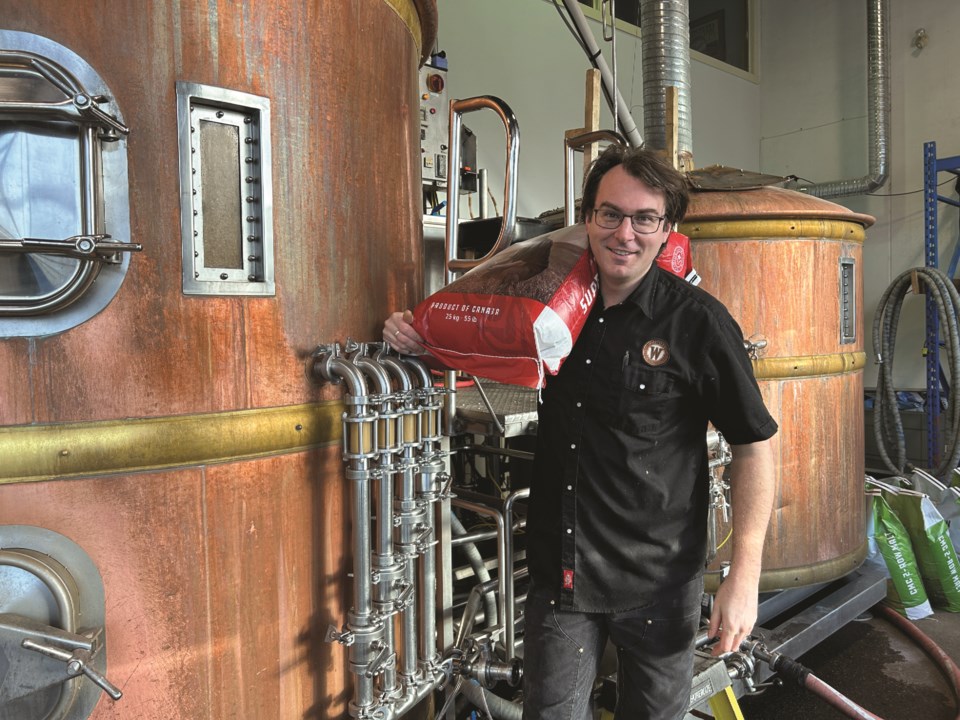Clinton Small, the brewmaster at Whistler Brewing Company, is quick to tell you that when it comes to science, “monkeying around” is when you do experiments—but don’t write things down.
In Clinton’s case, it’s a variation on the theme. You could say he’s been monkeying around since last summer doing experiments and test trials in pursuit of a tasty no- or low-alcohol beer (variously known as nolo or near beer). But true to his penchant for facts, rigour and all things mechanical, he’s been writing everything down.
“I’ve sent three brews for analysis and I’m seeing a favourable direction or result,” says the former Bearfoot Bistro chef, who originally hails from Port Macquarie, New South Wales.
Clinton connected to Whistler via Vancouver, where his wife, Monica, is from. Ten years ago, he in turn connected to Whistler Brewing, Whistler’s first local brewery and a pioneering B.C. microbrewery, which opened in 1989. While brewing up his own beer at home, he needed some empty bottles and Matt Dean, son of brewery owner Bruce Dean, happily obliged. Clinton soon traded the bistro scene for Whistler Brewing, the last five years as head brewer.
As you can see from the photo above, there’re a lot of cool angles to brewing beer on a commercial scale. That’s a 25-kilogram bag of Canada Malting’s Superior Pilsen malt from Alberta that Clinton’s lugging around. Primarily used for its ability to transform starches into simple fermentable sugars, the Pilsen malt (you guessed it, as in “pilsner” beer) is in most of their products, but in various concentrations.
As for those gorgeous copper tanks in the brewhouse, they’re part of the three-vessel system that can produce 2,000 litres of wort at one go—enough for 3,600 bottles of beer. The equivalent of “must” in wine-making, wort is the liquid that’s strained off the porridge-like “mash” of malt and hops. Later, yeast is added to the wort in the fermentation tanks, where it turns the sugars into alcohol.
That’s where Clinton’s “monkey business” comes in.
With the big social shift to nolo or non-alcoholic drinks (see below, and my earlier Pique column on nolos) which was happening well before the recent announcement from the Canadian Centre on Substance Use and Addiction that even a bit of alcohol—more than two drinks a week—carries an increased risk for some cancers, brewers like Clinton are keener than ever to find ways of either kicking the alcohol out of beer and the like, or not producing it in the first place.
Since alcohol is just another form of sugar, the key is to eliminate it without losing any of the pleasurable taste and mouthfeel we’ve all come to enjoy and expect. As for the “buzz” from booze, a lot of folks, especially millennials and Gen Z-ers, are finding that it, and the subsequent after-effects, aren’t that much fun after all. (See Veronica Woodruff’s excellent Jan. 12 feature [“Blind Drunk: A battle with my own subconscious”] in Pique for more on that angle.)
Thing is, big breweries with lots of bucks can afford to invest in new equipment that filters out most of the alcohol. But smaller ones, like Whistler Brewing, have to get creative and use different ways of fermenting, like using new yeasts that don’t make alcohol in the first place.
“Historically, why would you want a yeast that doesn’t formulate alcohol?” says Clinton. “Like, we’ve kind of done the opposite for hundreds of years—trying to get yeast that gobbles up all the sugar to make sure we get as much alcohol as possible. That was the goal, right?
“Now we want to ignore the sugars, and have a fermentation effect on the beer and not make the alcohol.”
Clinton has been pursuing what’s called a “mash manipulation” in his trial runs, pretty much keeping all the hardware the same but using higher temperatures for the “brewers’ window.”
The magical end game? “To make the beer like we’re used to and, as you can see, there’s no additional equipment so the boss is very happy about that,” Clinton laughs.
#Sober is sexy
Millions of people around the world have now waved bye-bye to “Dry January”—a booze-free month after a traditionally booze-saturated holiday season that was started 10 years ago by Alcohol Change UK, a British not-for-profit, to “ditch the hangover, reduce the waistline and save some serious money by giving up alcohol for 31 days.”
Dry January notwithstanding, nolos like near-beer are getting more and more attention than ever. Just check out the hashtag #soberissexy.
Solid statistics back up the trend. Even though there was plenty of goofing, and uptake, during the pandemic over booze-loaded drinks, like Pandemic Punch and Covid Ninetinis promising to blotto out the worst of lockdowns and fear, according to a 2021 Statistics Canada survey, about one in five Canadians surprisingly reported drinking less booze than they did in pre-COVID days. For younger ones, aged 15 to 29—millennials and Gen Zers—the number was even higher: A third said they had decreased their consumption of alcohol.
One U.S. market survey puts nolo sales in 2022 up 20-plus per cent over the previous year. And in Canada, marketers are predicting an eight-plus-per cent boost in near-beer sales in the coming year.
In a recent CBC article, even the Newfoundland Liquor Corporation’s chief marketing and merchandising officer, Peter Murphy, noted how younger people have different perceptions about drinking compared to older generations.
“They seem to consume less and/or no alcohol. And what they do consume are lighter in alcohol, calories, sugar or all of the above,” he wrote.
Bottom line: the liquor corporation, like outlets from Whistler to Winnipeg and beyond, is expanding its nolo offerings to keep pace with the young ones leading the way.
Glenda Bartosh is an award-winning journalist who had to discover booze-free drinks that taste good after she got malaria. She loves 0.0 percent Grolsch beer.




